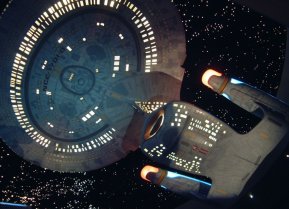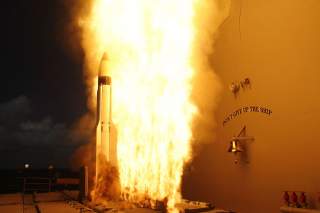Is Japan’s New Missile-Defense System Simply Unaffordable?
The costs keep going up.
The price of Japan’s new missile-defense system is quickly escalating, raising questions about whether it will ever be deployed.
On July 23, Kyodo News reported that Japan’s defense ministry now estimates that deploying two Aegis Ashore missile batteries could cost around 400 billion yen ($3.6 billion), roughly twice what Tokyo originally expected.
Kyodo cited a “government source” as providing the information. It did not further identify the source.
The cost actually rises when considering the system as a whole. According to Kyodo, when one includes the interceptors and other costs Tokyo now expects to pay about 600 billion yen ($5.4 billion) for the Aegis Ashore system.
A number of factors are contributing to the rising costs, the report noted. One factor is that Japan’s defense ministry wants to pair the Aegis Ashore system with Lockheed Martin’s SSR radar. The SSR radar is a variant of the Long Range Discrimination Radar.
Tokyo selected the SSR radar over the SPY-6 Air and Missile Defense Radar earlier this month. Along with better search capabilities, the decision was reportedly based on the SSR system having lower lifecycle costs.
Also pushing costs higher is that Japan intends to use the SM-3 Block IIA interceptors for the Aegis Ashore system. The most advanced SM-3 interceptors were co-developed by Japan and the United States and are expected to cost 4 billion yen ($36 million) each.
Raytheon, which is one of the companies involved in the SM-3 IIA interceptor, notes it has two distinct features compared with its predecessors: “larger rocket motors that will allow it to defend broader areas from ballistic-missile threats and a larger kinetic warhead. The interceptor’s kinetic warhead has been enhanced, improving the search, discrimination, acquisition and tracking functions, to address advanced and emerging threats.”
The SM-3 IIA interceptor is still being tested. So far, the results have been mixed. The interceptor failed to destroy missiles in tests in February 2018 and May 2017 but did succeed in one test in February 2017. It is expected to be used on the Aegis Ashore system the United States is deploying in Europe. Tokyo is also trying to acquire the interceptors for use on its sea-based Aegis destroyers.
Japan decided to add the Aegis Ashore system to its existing missile-defense architecture in December of last year.
“North Korea’s nuclear and missile development has become a greater and more imminent threat for Japan’s national security, and we need to drastically improve our ballistic-missile defense capability to protect Japan continuously and sustainably,” Japan’s cabinet said at the time.
The current plan is to deploy the two systems in 2023. One will be deployed in Akita prefecture and the other in Yamaguchi prefecture. Japanese sources have told Reuters that the decision about what radar to use will allow Tokyo to include the system in the budget proposal it submits some time in August. The budget the Defense Ministry submitted at the end of last year included funding for some exploratory work for the Aegis Ashore system.
Recommended: What Will the Sixth-Generation Jet Fighter Look Like?
Recommended: Imagine a U.S. Air Force That Never Built the B-52 Bomber
Recommended: Russia's Next Big Military Sale - To Mexico?
Some believe there will be growing opposition to the entire plan because of the mounting costs. In addition, there has been speculation that the summit between North Korean leader Kim Jong-un and President Donald Trump could cause some to question the need for the system.
Although there has been little, if any, specific evidence that Pyongyang is sincere about denuclearizing the summit has at least reduced tensions from the levels they were at for most of 2017. Of course, that could change at a moment’s notice.
Assuming the Aegis Ashore deployment is approved, it will add to one of the most sophisticated missile-defense systems in the world. Japan first began investing seriously in missile defense in the 1990s as China and North Korea were building up their respective missile arsenals.
Like the United States, it has pursued a multitiered approach, with capabilities to intercept ballistic missiles during different phases of flight (ballistic missiles have three phases: boost, midcourse and terminal).
Tokyo’s first line of defense comes from its Aegis-equipped destroyers. Japan’s Navy operates four Aegis-equipped Kongo-class destroyers, and is also building two new destroyers with a more advanced Aegis system, as well as upgrading its two current Atago-class destroyers with ballistic-missile-defense capabilities. These cover the mid-course phase.
If Japan’s Aegis-equipped ships fail to intercept a ballistic missile, Tokyo relies on its Pac-3 systems. These mobile systems can be deployed to protect high-value targets like military bases or cities.
The Pac-3 systems use hit-to-kill interceptors to take out ballistic missiles during their final, terminal phase. Japan is currently looking to upgrade its Patriot batteries with the Missile Segment Enhancement (MSE), which improves the interceptors’ range, mobility and precision.
Given the track record of missile-defense systems, not to mention the growing missile threats Japan faces from North Korea and China, there is no way Japan’s current missile-defense systems are adequate to protect the country. The Aegis Ashore system certainly wouldn’t solve the problem but it would help.
Zachary Keck (@ZacharyKeck) is a former managing editor of the National Interest.
Image: Wikimedia Commons


